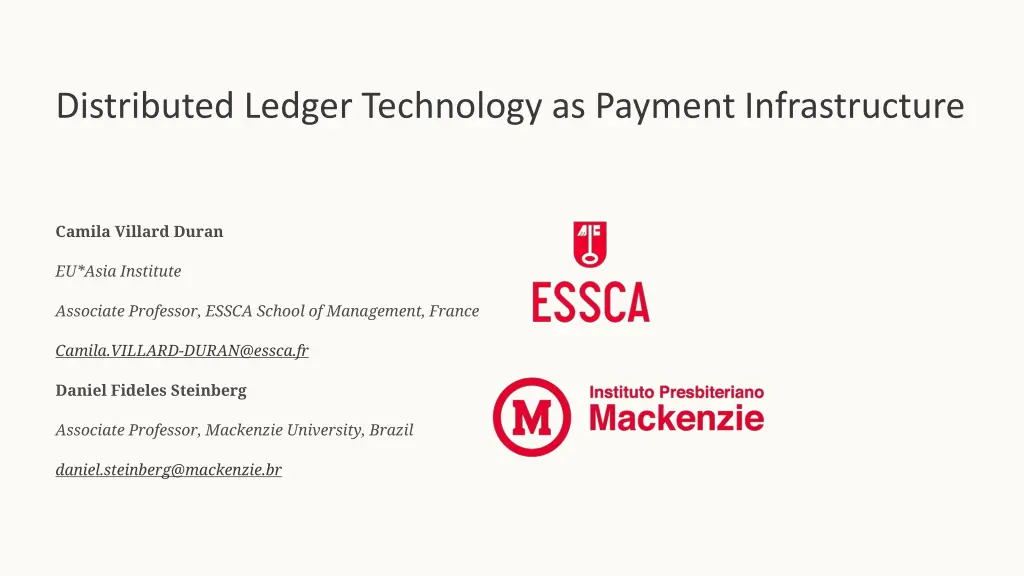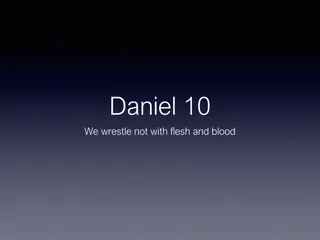
Understanding the Impact of Distributed Ledger Technology on International Payments
Explore the influence of Distributed Ledger Technology (DLT) on global payment infrastructure, including the role of Central Bank Digital Currencies (CBDCs) in reshaping monetary sovereignty. Discover how DLT can transform the operational environment and challenge existing financial systems.
Download Presentation

Please find below an Image/Link to download the presentation.
The content on the website is provided AS IS for your information and personal use only. It may not be sold, licensed, or shared on other websites without obtaining consent from the author. If you encounter any issues during the download, it is possible that the publisher has removed the file from their server.
You are allowed to download the files provided on this website for personal or commercial use, subject to the condition that they are used lawfully. All files are the property of their respective owners.
The content on the website is provided AS IS for your information and personal use only. It may not be sold, licensed, or shared on other websites without obtaining consent from the author.
E N D
Presentation Transcript
Distributed Ledger Technology as Payment Infrastructure Camila Villard Duran EU*Asia Institute Associate Professor, ESSCA School of Management, France Camila.VILLARD-DURAN@essca.fr Daniel Fideles Steinberg Associate Professor, Mackenzie University, Brazil daniel.steinberg@mackenzie.br
Key Elements of the Article International payments remain heavily reliant on privately led infrastructure. This is a key component of the current International Monetary System (IMS), which is built upon a foundation of public legal frameworks, but even more so on private legal and operational norms. Institutions like SWIFT and CHIPS are critical infrastructural providers that exert structural power by defining the "rules of the game," thereby shaping the operational environment for both private actors and public entities (Petry, 2020). Central Bank Digital Currency (CBDC) initiatives have the potential to reshape monetary sovereignty. They could lead to a more state-driven technological approach to cross-border payments, reducing dependence on systems like CHIPS for settlement and SWIFT for messaging. CBDCs (leverage on DLT) may also serve as a geopolitical instrument, challenging the dominance of U.S.-based financial infrastructure. The mBridge project serves as a case study demonstrating how CBDCs can transform the global financial architecture by reconfiguring the underlying payment infrastructure. BIS Innovation Hub as a central element in coordinating efforts.
Understanding the Current International Monetary Monetary System (IMS) Payment Infrastructure Hybrid Nature IMS Framework A defining legal characteristic is the hybrid (public-private) nature of money and the rules that support it, which have evolved into a more complex landscape due to financial globalization. SWIFT (private) are in the center of such framework, which infrastructural power Dieterich, 2023). Not neutral financial devices. They establish technological standards, becoming geopolitical tool. They establish technological and legal standards, becoming geopolitical tool within the IMS. In the financial domain, law is not merely an external constraint constitutive of economic transactions (Deakin et al., 2017) Referred (Giovanoli, monetary order (Carreau, 1988, 1998). The International Monetary System consists frameworks governing monetary interactions between governmental bodies, and economic actors. as a non-system or private and legal 2000) a critical of institutional and CHIPS States, impacts in but is (Brandl,
The Current Global Payment Infrastructure SWIFT Network CHIPS Eurodollar Market A private association that acts as a standard-setter in global messaging traffic for financial characterizes itself as a backbone of global financial communication aimed at facilitating economic transactions. The infrastructural services provided by SWIFT have shaped its own environment rather responding to it (Scott & Zachariadis, 2014:153) The Payments System in New York, processing an average of US$ 1.8 trillion in international payments Currently, CHIPS serves as a net settlement system for high-value international transactions in US dollars and operates alongside its public counterparty, the Fedwire system. Clearing House Interbank The primary form of international private money , representing short- term liabilities issued by global banks operating beyond national authorities' reach. important with the globalization of finance (Mckinnon, 1969, 1977; Kindleberger, 1969; Carreau, 1988, 1998; Duran, 2020) communications. domestic and daily. historically than simply These three components form essential institutional elements of a global, privately-led payment infrastructure that legally frames monetary transactions across various jurisdictions. They are not politically neutral (Deng, 2023); they define the contours of governance and become part of geopolitical action.
Monetary Sovereignty in the Current IMS Definition Constraints Unequal Distribution Monetary sovereignty encompasses the authority to define legal tender within a jurisdiction (Skinner, 2023), governance infrastructures, control over money supply, and determination of interest rates. Monetary sovereignty has diminished in recent years, notably in the international arena due to globalization, technological advancements, and financial crises. Currency competition, the enduring dominance of the US dollar, and the expanding effects of international private money challenge the notion of States as equal constitutive building blocks within the IMS (Braun et al., 2021; Murau et al., 2020; Gabor, 2016; Cohen, 2015; Aldasoro & Ehlers, 2018). While authority over currency issuance within borders, only a select few privileged States enjoy the political power to extend their monetary sovereignty beyond jurisdictions. countries maintain legal of payment their The effectiveness of the US's extra-jurisdictional legal power is largely dependent on the fact that its currency is widely traded as money by international actors. Beyond territorial governance, control over money and finance fundamentally determines the actual sovereignty of a State at global levels.
Infrastructural Geopolitics Establishing technological and legal standards for infrastructures becomes a decisive geopolitical tool (de Goede, 2021; de Goede, Westermeier, 2022). Hegemonic dispositions can manifest through payment systems, which goes beyond its role as a passive apparatus for the settlement of legal obligations in financial markets. Legal Frameworks Infrastructure Power Beyond public laws, the legal frameworks defining contractual agreements over money are key features in delineating rights and obligations. Payment systems actively participate in the global political landscape, exerting influence by obstructing, contesting, or reshaping power dynamics. 1 2 Global Standards Strategic Control The adoption of a currency as an international means of payment depends on the dissemination and acceptance of underlying technologies and their correspondent legal rules. Control over payment infrastructure provides strategic advantages in international relations and economic governance. 4 3
Elements of a DLT-based Sovereign Currency Central Bank Liability A currency issued by a central bank on a DLT platform 1 Legal Tender Status 2 Recognized as official currency by law (Skinner, 2023). Eliminate solvency risks (Kumhof et al, 2020) Programmability 3 Smart contracts and conditional transactions (Seidemann, 2021) Security Features 4 Cryptographic techniques ensuring tamper-proof records Atomic Settlements 5 Instant and conditional exchange of assets Unlike cash or traditional bank money, tokens are programmable. The parties in a transaction can codify smart contracts, i.e., self-executing agreements coded when predefined events take place. This feature represents a financial innovation of equal significance to the historical developments of the double-entry accounting system or the issuance of bank money.
Advantages of DLT for Cross-Border Transactions Efficiency Security Interoperability Programmability DLT-based tokens can convey both payment information and direct transfer of value, reducing intermediaries and expediting transaction settlement. CBDCs can offer enhanced security by eliminating solvency risks, positioning them as a strategic form of central bank money in this new monetary infrastructure. Wholesale sovereign money can facilitate interoperability between different 'monies' during the transition to a new infrastructure. Smart contracts enable conditional transactions and automated compliance with regulatory requirements. In cross-border transactions, DLT-based tokens set themselves apart from the traditional global financial infrastructure, which is marked by the segregation between SWIFT communications and the use of a eurocurrency as international money along with the CHIPS' payment infrastructure.
The BIS Innovation Hub and Multi-CBDC Platforms 1 2019: Establishment Advancing projects since 2015. The BIS Innovation Hub was established to enhance understanding of financial technology within the central banking community. 2 2020: G20 Endorsement G20 Finance Ministers endorsed a plan to overhaul international payments, giving political support to alternative cross-border payment systems. 3 2021-2022: Project Development Development of multi-CBDC platforms like mBridge and Project Dunbar to explore interoperability and cross-border 4 2023-2024: Implementation and Testing settlements. Real-value transactions conducted on mBridge platform, involving banks conducting transactions on behalf of corporate clients. The BIS Innovation Hub has been providing the institutional framework for central bank cooperation on money creation within DLT platforms, enabling the exchange of 'multiple currencies within a single system' instead of multiple ledgers to be updated across multiple systems.
Project mBridge: A Case Study Technical Architecture Multi-CBDC Platform Legal Framework mBridge involving the Hong Kong Monetary Authority and the central banks of China, Thailand, and the United Arab Emirates, designed challenges in international payments. It enable the exchange currencies within a single system (Bech et al, 2022). is a milestone project A new native blockchain platform was created: permissioned DLT mBridge ledger (mBL), where central banks are validator participating in protocol. The 'mBridge Platform terms' serves as a binding contract between the mBridge administrator, banks, and the corresponding bank participants, outlining access, usage, and settlement conditions. a purpose-built named the central to alleviate nodes the consensus of multiple In October 2024, Agust n Carstens, the General Manager of the BIS, declared that the BIS was leaving the mBridge project and the partners (the central bankers involved) will carry it by themselves, having fulfilled its "seed" role by fostering financial innovation during the early stages.
BRICS-Bridge Initiative Geopolitical Context Strategic Objectives Current Status The BRICS-Bridge is a proposal introduced at the 2024 BRICS summit aimed at creating a seamless DLT- payment system among Brazil, Russia, India, China, and South Africa. A payment infrastructure that bypasses traditional Western financial channels would provide protection against sanctions imposed by G7 countries. The BRICS-Bridge has so far been primarily symbolic, serving as a geopolitical statement rather than a technically robust initiative. Its development has lacked substantive technical engagement from key stakeholders, and the project did not feature in the final communiqu of the BRICS summit in 2024. In Putin's vision, this system represents a strategic move toward reducing reliance on the U.S. dollar and establishing a more autonomous financial framework for BRICS nations. This vision of geopolitical financial independence from the BRICS countries is not new: in 2023, Brazilian President Lula questioned why all countries have to base their trade on the dollar.
Comparing mBridge and BRICS-Bridge Feature mBridge BRICS-Bridge Development Stage Advanced - achieved direct settlement of real-value transactions Initial - primarily conceptual at this point Technical Robustness High - purpose-built permissioned DLT with defined architecture Low - lacks substantive technical engagement Institutional Support BIS Innovation Hub (until 2024) and participating central banks Political support from BRICS nations but limited institutional framework Primary Motivation Enhancing efficiency in cross-border payments Geopolitical independence from Western financial systems Current Status Transitioning from BIS oversight to central bank management Symbolic proposal without concrete implementation plan
Impact on Monetary Sovereignty Swift on Infrastructural Power Reduced Dependency Embedded Regulatory Framework Framework Potentially reducing reliance on eurodollar market and Western payment networks. States would set standards for private institutions, embedding norms into platform code. While money creation would remain a public-private arrangement, government authorities would play a larger role. Multi-CBDC platforms could shift control from private norms to a more state-centric structure. It can make countries sovereignty. enhance their There is a relationship between the degree of monetary sovereignty enjoyed by States (weak or strong) and the correspondent payment infrastructure for cross-border transactions at global levels (more State-driven or private-led infrastructure). By investing in multi-CBDC platforms, countries can enhance their sovereignty in monetary affairs through DLT-based initiatives, enabling direct exchange of their own currencies.
Potential Challenges and Inequalities: Fragmentation Global challenges may arise as states face disparities in accessing the necessary expertise and resources to develop and implement new financial technologies like DLT. This disparity could potentially exclude many emerging market economies and developing countries from central bank cooperation on a global scale. Additionally, variations in implementation may lead to differing CBDC legal formats and regulations across jurisdictions. These differences increase the likelihood of multiple 'CBDC clusters' (Wang & Gao, 2023) forming, suggesting a possible fragmentation of the future DLT-based international monetary system. However, collaboration among states could enhance sovereignty by creating 'CBDC clusters' based on shared economic and political goals (Wang & Gao, 2023), fostering a transnational financial system less reliant on traditional private-dominated payment structure.
The Role of Multilateral Cooperation BIS as Coordinator Regional Cooperation Technical Standardization The BIS is reinforcing its role as a moderator among national authorities, investing in multi-CBDC platforms for cross-border transactions as a form of public good. Collaboration on technical standards is essential to ensure between different CBDC implementations and existing payment systems. Regional economic blocs may form their own CBDC clusters based on shared economic interests and existing trade relationships. interoperability To address inequalities in the emerging DLT-based monetary system, multilateral cooperation among states and financial institutions will be essential. As global monetary practices, policies, and laws become more complex to address technological issues, international coordination becomes increasingly important.
Can DLT reshape the IMS? The emergence of CBDCs, supported by DLT, may represent a significant shift from a privately-led to a more State-centric payment system, challenging the traditional dominance of the eurodollar as international private money along with the SWIFT and CHIPS networks in global payments. Wholesale CBDCs could fundamentally transform the architecture of international payments, enhancing the monetary sovereignty of States by reducing their dependence on traditional private-sector legal mechanisms. This shift could result in a more fragmented IMS, realigning power dynamics to favor specific groups of States that invest in this financial infrastructure.






















